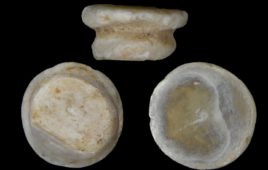Heliconius butterfly (center) with a zoomed in image of wing scale color and pattern (left) and its corresponding stained wing pattern (right) with darker purple areas denoting where the optix gene is expressed prior to red pigmentation. |
Many tropical butterflies and moths have strikingly beautiful wing colors
and patterns. To scientists, though, studying these colors and patterns is less
about beauty and more about learning how some butterflies and moths have
managed to evolve deceptively similar or exceptionally diverse color patterns.
When butterflies mimic the wing patterns and colors of other butterflies who
successfully avoid predators, for instance, how does this work at a genetic
level? Is mimicry the result of a simple genetic switch turned on in each
species to yield similar wing patterns? Or is the genetic programming much more
complex than that?
In a paper published in Science, Heather Hines, a North Carolina State
post-doctoral genetics researcher, and collaborators show that an eye gene
called optix
appears to be responsible for the red patterns in tropical Heliconius
butterfly wings. The authors made the discovery by comparing the genes that are
turned on in butterflies with different color patterns. The somewhat surprising
proof of this single gene’s role came when—in a stage of development before
color was produced—the researchers stained wings wherever optix
occurred. They found the staining exactly matched the future distribution of
the red pigments—so well, in fact, that they could identify species by the
staining pattern alone.
“We finally found the gene switching these patterns on and off, but we also
determined that this gene is being used across a diversity of butterflies,
suggesting that a common genetic mechanism is employed across mimetic
butterflies to yield the same pattern,” Hines says.
Optix
is otherwise known only for its role in eye development, Hines adds, which adds
further intrigue to the study. Why would an eye gene be responsible for wing
colors or patterning? Hines and her colleagues have a guess: The red pigments
that optix
turns on are called ommochromes, pigments best known for their use as filtering
pigments in the eye. Production of optix outside its typical location could lead to the production of “eye”
pigments in the wing. Further, Heliconius
male butterflies prefer their own color pattern in mates, raising the
possibility that optix
could be programming both color pattern and visual mate preference.





